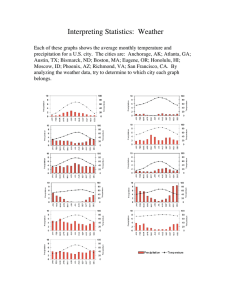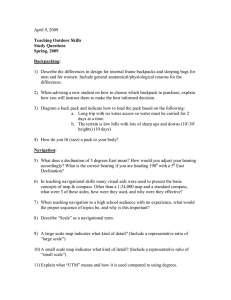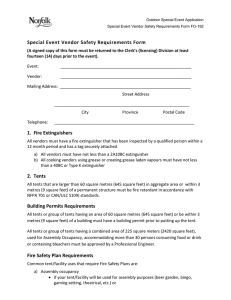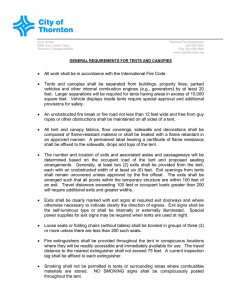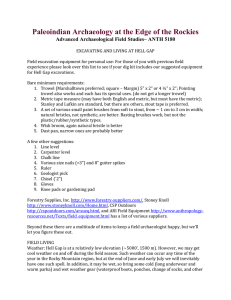Fire Marshal`s Office
advertisement
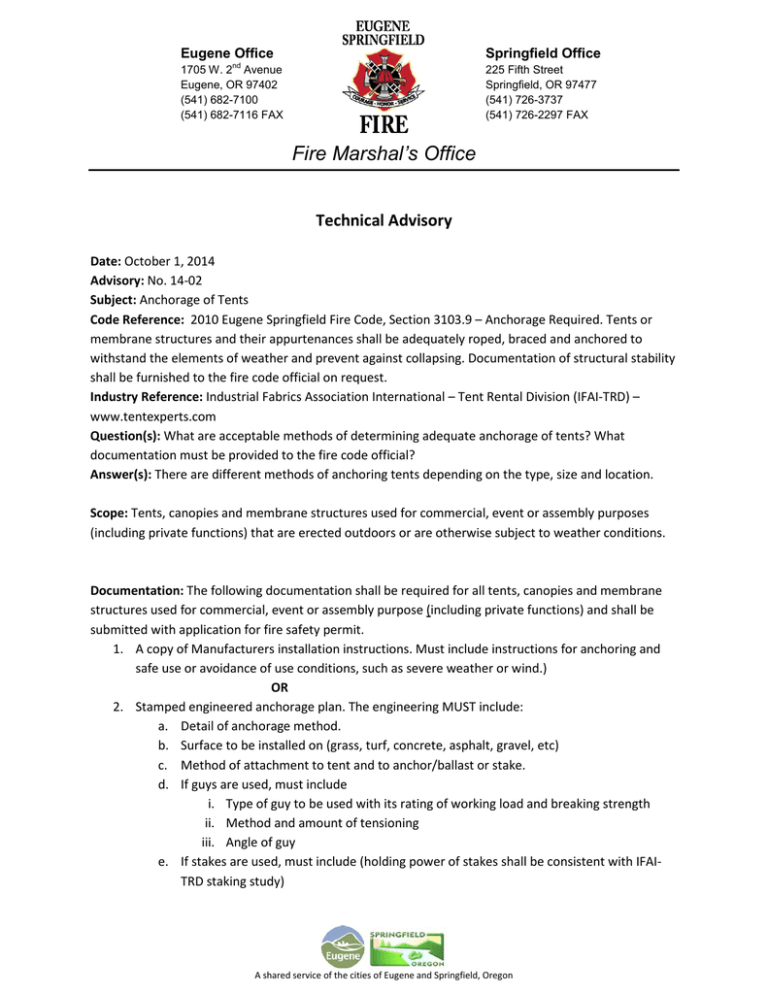
Eugene Office Springfield Office nd 1705 W. 2 Avenue Eugene, OR 97402 (541) 682-7100 (541) 682-7116 FAX 225 Fifth Street Springfield, OR 97477 (541) 726-3737 (541) 726-2297 FAX Fire Marshal’s Office Technical Advisory Date: October 1, 2014 Advisory: No. 14-02 Subject: Anchorage of Tents Code Reference: 2010 Eugene Springfield Fire Code, Section 3103.9 – Anchorage Required. Tents or membrane structures and their appurtenances shall be adequately roped, braced and anchored to withstand the elements of weather and prevent against collapsing. Documentation of structural stability shall be furnished to the fire code official on request. Industry Reference: Industrial Fabrics Association International – Tent Rental Division (IFAI-TRD) – www.tentexperts.com Question(s): What are acceptable methods of determining adequate anchorage of tents? What documentation must be provided to the fire code official? Answer(s): There are different methods of anchoring tents depending on the type, size and location. Scope: Tents, canopies and membrane structures used for commercial, event or assembly purposes (including private functions) that are erected outdoors or are otherwise subject to weather conditions. Documentation: The following documentation shall be required for all tents, canopies and membrane structures used for commercial, event or assembly purpose (including private functions) and shall be submitted with application for fire safety permit. 1. A copy of Manufacturers installation instructions. Must include instructions for anchoring and safe use or avoidance of use conditions, such as severe weather or wind.) OR 2. Stamped engineered anchorage plan. The engineering MUST include: a. Detail of anchorage method. b. Surface to be installed on (grass, turf, concrete, asphalt, gravel, etc) c. Method of attachment to tent and to anchor/ballast or stake. d. If guys are used, must include i. Type of guy to be used with its rating of working load and breaking strength ii. Method and amount of tensioning iii. Angle of guy e. If stakes are used, must include (holding power of stakes shall be consistent with IFAITRD staking study) A shared service of the cities of Eugene and Springfield, Oregon Eugene Office Springfield Office nd 1705 W. 2 Avenue Eugene, OR 97402 (541) 682-7100 (541) 682-7116 FAX 225 Fifth Street Springfield, OR 97477 (541) 726-3737 (541) 726-2297 FAX Fire Marshal’s Office i. Diameter of stake – minimum 1” ii. Length of stake iii. Angle of stake insertion iv. Depth of stake insertion v. Staking diagram f. If Ballast is used - NOTE: Plastic barrels are NOT an acceptable form of ballast. i. Calculations must include 1. Coefficient of friction between anchor/ballast and surface 2. Height and angle of attachment 3. Amount of ballast shall be calculated by using the IFAI-TRD ballast tool and a copy of the results shall be provided. g. Wind speed in MPH the design is good for OR 3. For tents without manufacturer’s installation instructions or engineering - An anchorage plan complying with the following minimum standards MAY be accepted – NOTE: Plastic barrels are NOT an acceptable form of ballast. a. For 10 x 10 pop up tents that are not wind rated i. Plan shall be based on minimum wind load factor of 5lbs/sqft for tents without sides (during operational period) and 10 lbs/sqft with sides. Ballast shall be distributed equally among all legs and secured to each leg. ii. Tents shall be evacuated if wind reaches 15 mph. b. For tents larger than 10 x 10 that are not wind rated the plan shall be based on a minimum wind load factor of 5 lbs/sqft for tents without sides and 10 lbs/sqft for tents with sides equal to or greater than the length of the shortest side for wind speeds less than 30 mph and 10 lbs/sqft without sides and 15 lbs/sqft for tent with sides equal to or greater than the length of the shortest side for wind speeds from 31 to 40 mph. i. The load shall be determined by the following: Length x Width x Wind Load factor = total load. 1. Example: 20w x 20l x 10lbs = 4,000 lbs Wind Load Factor ii. The load shall be distributed between all connections points either equally or as instructed by the manufacturer. 1. Example: 20 x 20 pole tent with 12 rope/guy connections: 4,000 lbs/12 = 333.33 lbs per anchorage location. A 20 x 20 frame tent with 8 rope/guy locations: 4,000 lbs/ 8 = 500 lbs per anchorage location. A shared service of the cities of Eugene and Springfield, Oregon Eugene Office Springfield Office nd 1705 W. 2 Avenue Eugene, OR 97402 (541) 682-7100 (541) 682-7116 FAX 225 Fifth Street Springfield, OR 97477 (541) 726-3737 (541) 726-2297 FAX Fire Marshal’s Office iii. The type of rope and/or guy to be used with its rating of working load and breaking strength. iv. If stakes are used the minimum diameter shall be 1”. The holding power of the stake shall be determined by using the Industrial Fabrics Association International – Tent Rental Division method (IFAI-TRD) (see tentexperts.com). For stakes without a head, OSHA approved protection must be provided. v. If ballast is used the amount of ballast shall be calculated by using the Industrial Fabric Association International – Tent Rental Division (IFAI-TRD) (see tentexperts.com) Ballast tool with the results provided with the permit submission. c. For tents that are wind rated the plan shall be based on the loads provided by the manufacturer at minimum in a generic stamp drawing. Staking or ballasting plans shall conform to the Industrial Fabrics Association International – Tent Rental Division (IFAITRD) for calculating staking and/or ballasting to provide the required anchorage (see tentexperts.com). d. The fire code official may require site specific stamped engineering for any tent, canopy and membrane structure. 4. For sites that have permanently installed attachment points – a. Provide proof of anchor strength (pull test) b. Attachment details 5. A written operational/ evacuation plan shall be provided to the end user and the fire code official. The plan shall include: a. The party responsible for monitoring wind speed. i. A log SHALL be kept recording wind speed at 30 minute intervals of the scheduled event. b. The method of monitoring wind speed. c. The party responsible for evacuation of the tent. d. The wind speed that will be used to determined when to evacuate. i. For tents that are not wind rated, the tents, canopies and membrane structures shall withstand winds for 5 minutes at the following wind speeds and evacuate: 1. For tents with occupancy under 10 persons: 15 mph 2. For tents with occupancy from 11-199 persons: 25 mph 3. For tents with occupancy from 200-499 persons: 35 mph 4. For a tent with occupancy over 500 persons the tent must be either wind rated or a stamp site specific engineering for a non wind rated tent A shared service of the cities of Eugene and Springfield, Oregon Eugene Office Springfield Office nd 1705 W. 2 Avenue Eugene, OR 97402 (541) 682-7100 (541) 682-7116 FAX 225 Fifth Street Springfield, OR 97477 (541) 726-3737 (541) 726-2297 FAX Fire Marshal’s Office stating the wind speed the tent is capable of providing. The evacuation wind speed will be the rating less 15 mph. A shared service of the cities of Eugene and Springfield, Oregon
